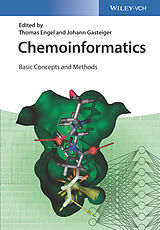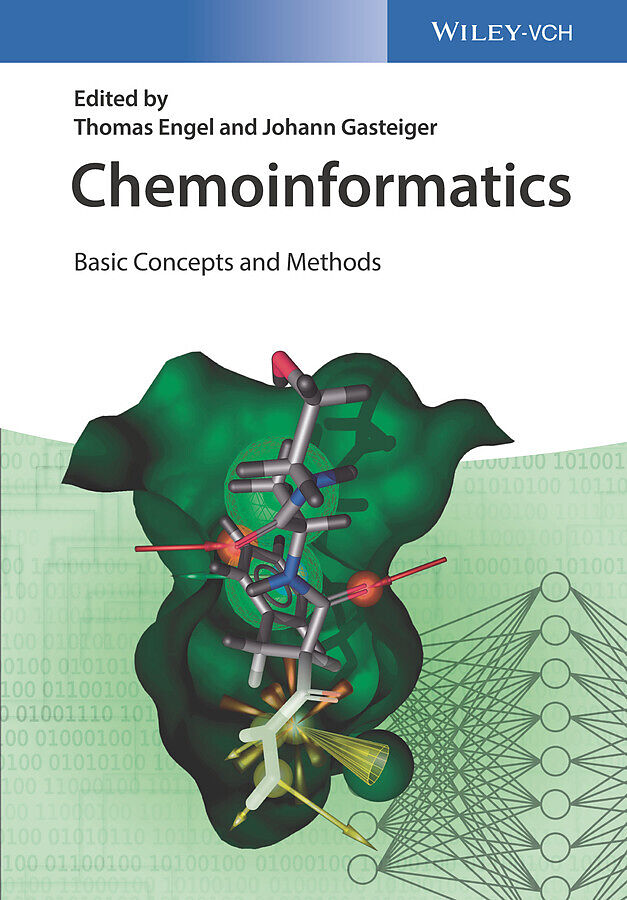Chemoinformatics
Format:
E-Book (pdf)
EAN:
9783527693771
Untertitel:
Basic Concepts and Methods
Genre:
Chemie
Autor:
Thomas Engel, Johann Gasteiger
Herausgeber:
Wiley-VCH
Anzahl Seiten:
608
Erscheinungsdatum:
18.05.2018
Von den Grundlagen zu Methoden - dieses Fachbuch, übersichtlich und didaktisch klar gegliedert, ist eine maßgebliche Handreichung mit allem Wissenswerten und Erläuterungen der Tools in diesem Fachgebiet.
Autorentext
Johann Gasteiger is Professor emeritus of Chemistry at the University of Erlangen-Nuremberg, Germany and the co-founder of "Computer-Chemie-Centrum". He has received numerous awards and is a member of several societies and editorial boards. His research interests are in the development of software for drug design, simulation of chemical reactions, organic synthesis design, simulation of spectra, and chemical information processing by neural networks and genetic algorithms.
Thomas Engel is is coordinator at the Department of Chemistry and Biochemistry of the Ludwig-Maximilians-Universitat in Munich, Germany. He received his academic degrees at the University of Wurzburg. Since 2001 he is lecturer at various universities promoting and establishing courses in scientific computing. He is also a member of the Chemistry-Information-Computer section (CIC) of the GDCh and the Molecular Graphics and Modeling Society (German section).
Klappentext
This essential guide to the knowledge and tools in the field includes everything from the basic concepts to modern methods, while also forming a bridge to bioinformatics.
The textbook offers a very clear and didactical structure, starting from the basics and the theory, before going on to provide an overview of the methods. Learning is now even easier thanks to exercises at the end of each section or chapter. Software tools are explained in detail, so that the students not only learn the necessary theoretical background, but also how to use the different software packages available. The wide range of applications is presented in the corresponding book Applied Chemoinformatics - Achievements and Future Opportunities (ISBN 9783527342013). For Master and PhD students in chemistry, biochemistry and computer science, as well as providing an excellent introduction for other newcomers to the field.
Inhalt
Foreword xxi List of Contributors xxv 1 Introduction 1
Thomas Engel and Johann Gasteiger 1.1 The Rationale for the Books 1 1.2 The Objectives of Chemoinformatics 2 1.3 Learning in Chemoinformatics 4 1.4 Outline of the Book 5 1.5 The Scope of the Book 7 1.6 Teaching Chemoinformatics 8 References 8 2 Principles of Molecular Representations 9
Thomas Engel 2.1 Introduction 9 2.2 Chemical Nomenclature 11 2.2.1 Non-systematic Nomenclature (Trivial Names) 11 2.2.2 Systematic Nomenclature of Chemical Compounds 12 2.2.3 Drawbacks of Chemical Nomenclature for Data Processing 12 2.3 Chemical Notations 12 2.3.1 Empirical Formulas of Inorganic and Organic Compounds 12 2.3.2 Line Notations 14 2.4 Mathematical Notations 14 2.4.1 Introduction into Graph Theory 15 2.4.2 Matrix Representations 18 2.4.2.1 Adjacency Matrix 18 2.4.2.2 Incidence Matrix 19 2.4.2.3 Distance Matrix 20 2.4.2.4 Bond Matrix 21 2.4.2.5 BondElectron Matrix 21 2.4.2.6 Summary on Matrix Representations 23 2.4.3 Connection Table 23 2.5 Specic Types of Chemical Structures 25 2.5.1 General Concepts of Isomerism 25 2.5.2 Tautomerism 26 2.5.3 Markush Structures 27 2.5.4 Beyond a Connection Table Representation 28 2.5.4.1 Representation of Molecular Structures by Electron Systems 28 2.6 Spatial Representation of Structures 31 2.6.1 Representation of Congurational Isomers 32 2.6.2 Chirality 33 2.6.3 3D Coordinate Systems 36 2.7 Molecular Surfaces 37 Selected Reading 38 References 393 3 Computer Processing of Chemical Structure Information 43
Thomas Engel 3.1 Introduction 43 3.2 Standard File Formats for Chemical Structure Information 44 3.2.1 SMILES 44 3.2.1.1 Stereochemistry in SMILES 47 3.2.1.2 Summary on SMILES 47 3.2.2 SMARTS 47 3.2.3 SYBYL Line Notation 48 3.2.4 The International Chemical Identier (InChI) and InChIKey 48 3.2.5 XYZ Format 50 3.2.6 Z-Matrix 51 3.2.7 The Molle Format Family 52 3.2.7.1 Structure of a Molle 53 3.2.7.2 Stereochemistry in the Molle 57 3.2.7.3 Structure of an SDle 57 3.2.8 The PDB File Format 58 3.2.8.1 Introduction/History 58 3.2.8.2 General Description 58 3.2.8.3 Analysis of a Sample PDB File 60 3.2.9 Metadata Formats 65 3.2.9.1 STAR-Based File Formats and Dictionaries 65 3.2.9.2 CIF File Format 66 3.2.9.3 mmCIF File Format 67 3.2.9.4 CML 68 3.2.9.5 CSRML 68 3.2.10 Libraries for Handling Information in Structure File Formats 69 3.3 Input and Output of Chemical Structures 70 3.3.1 Molecule Editors 72 3.3.2 Molecule Viewers 73 3.4 Processing Constitutional Information 73 3.4.1 Structure Isomers and Isomorphism 73 3.4.2 Tautomerism 74 3.4.3 Unambiguous and Biunique Representation by Canonicalization 76 3.4.3.1 The Morgan Algorithm 77 3.4.4 Ring Perception 79 3.4.4.1 Introduction 79 3.4.4.2 Graph Terminology 80 3.4.4.3 Ring Perception Strategies 81 3.5 Processing 3D Structure Information 86 3.5.1 Detection and Specication of Chirality 86 3.5.1.1 Detection of Chirality 87 3.5.1.2 Specication of Chirality 87 3.5.2 Automatic Generation of 3D Structures 90 3.5.3 Automatic Generation of Ensemble of Conformations 94 3.6 Visualization of Molecular Models 100 3.6.1 Introduction 100 3.6.2 Models of the 3D Structure 101

Leider konnten wir für diesen Artikel keine Preise ermitteln ...
billigbuch.ch sucht jetzt für Sie die besten Angebote ...
Die aktuellen Verkaufspreise von 3 Onlineshops werden in Realtime abgefragt.
Sie können das gewünschte Produkt anschliessend direkt beim Anbieter Ihrer Wahl bestellen.
Loading...
Die aktuellen Verkaufspreise von 3 Onlineshops werden in Realtime abgefragt.
Sie können das gewünschte Produkt anschliessend direkt beim Anbieter Ihrer Wahl bestellen.
| # | Onlineshop | Preis CHF | Versand CHF | Total CHF | ||
|---|---|---|---|---|---|---|
| 1 | Seller | 0.00 | 0.00 | 0.00 |
